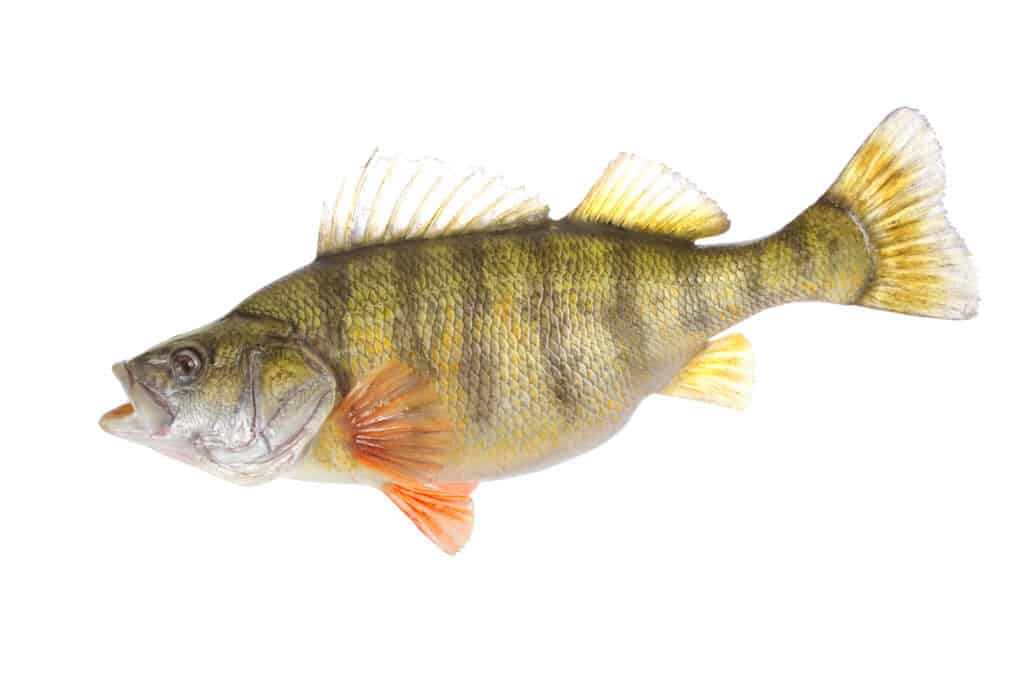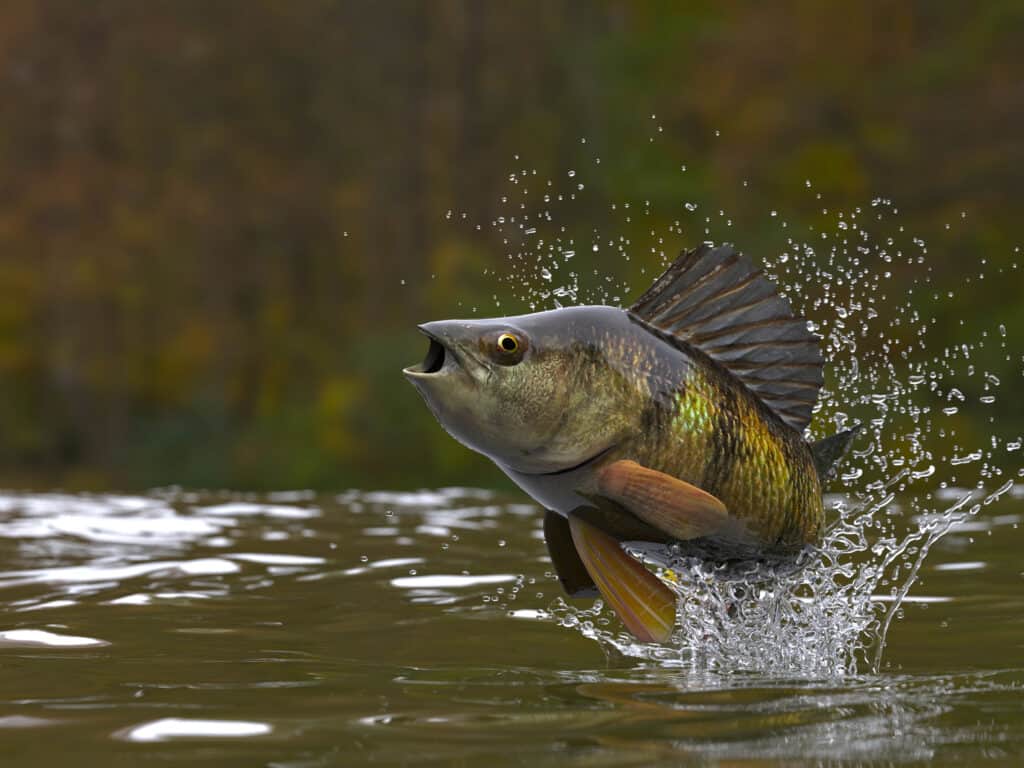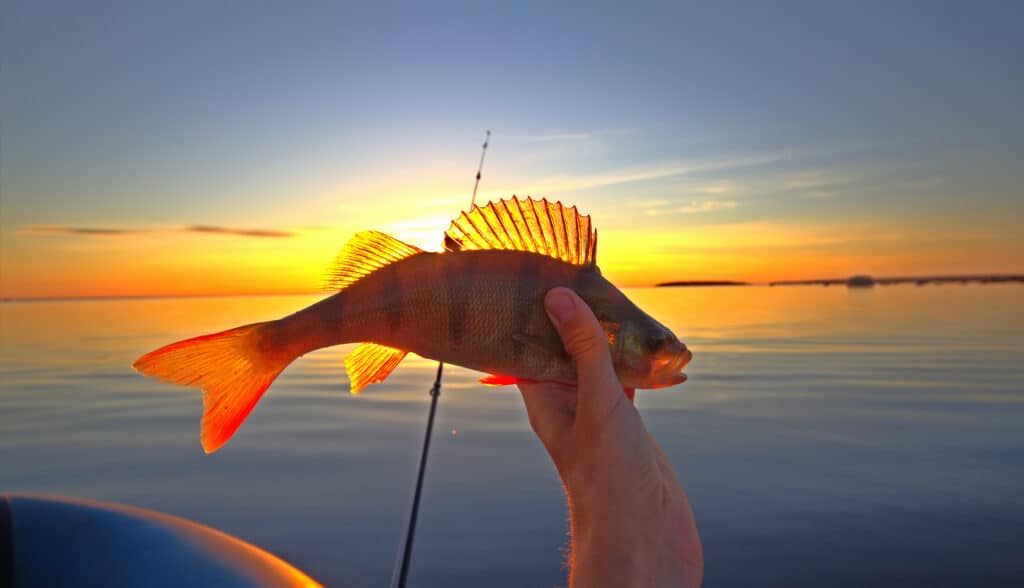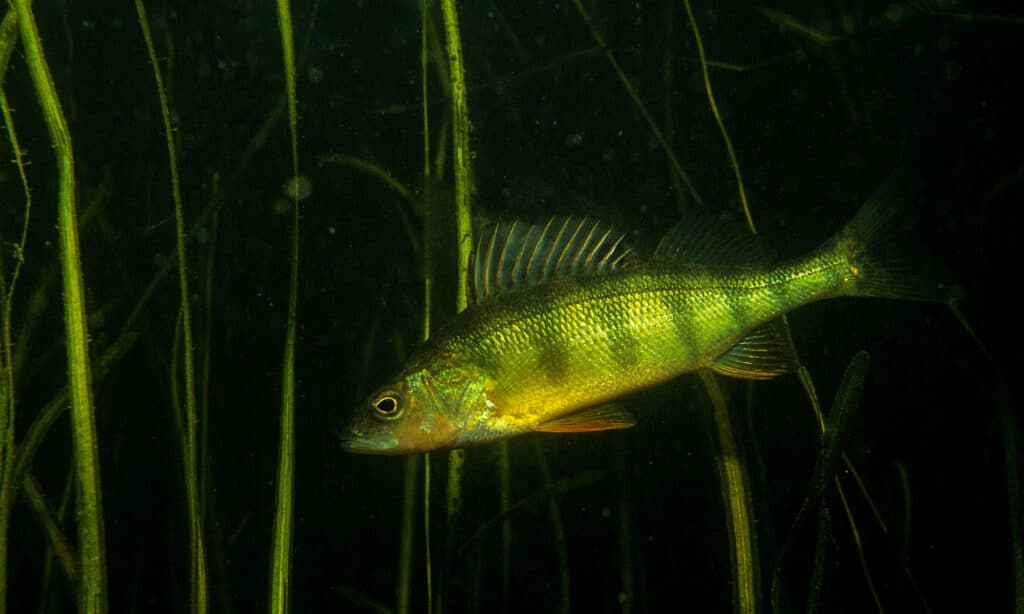With their vibrant yellow fins, greenish back, and appealing flavor, yellow perch are a popular freshwater game fish targeted by anglers across North America. But just how big do these striped swimmers get? In this article, we’ll explore the average and maximum sizes of yellow perch, compare them to other fish species and objects, and look at where and when to catch these scrappy perch. Read on for an in-depth look at the dimensions of this iconic fish.

Adult yellow perch are around 6 to 10 inches in length.
©Keith Publicover/Shutterstock.com
The Average and Maximum Size of Yellow Perch
Yellow perch generally live for 6 to 10 years, with adults ranging from 6 to 10 inches in length. The weight of a mature yellow perch typically falls well under a pound. They are characterized by an elongate, laterally compressed body, a relatively long but blunt snout, and many fine teeth. A yellow perch’s maximum recorded total length is 50 centimeters (20 inches), and the maximum published weight is 4.2 lbs.
The Largest Yellow Perch Ever Recorded/Caught
Dr. C. Abbot caught the most prominent yellow perch in Bordentown, New Jersey, in May 1865. The fish was 18 inches (46 cm) long and weighed 4 lb 3 oz (1.9 kg). This is the oldest standing freshwater world record.
Size Comparison with Other Perch Types
| Species | Avg. Length | Max Length | Avg. Weight | Max Weight |
|---|---|---|---|---|
| Yellow Perch | 4-10 inches | 15-19.7 inches | Under 1 lb. | 4 lbs. |
| Walleye | 12-30 inches | 40 inches | 5-20 lbs. | 25 lbs. |
| Sauger | 10-18 inches | 20 inches | 1-2 lbs. | 8 lbs. |
| Logperch | 3-6 inches | 5-7 inches | Under 1 lb. | 1 lb. |
Yellow Perch Size Compared to Other Fish, Animals, and Inanimate Objects
Compared to an average human hand, a mature Yellow Perch (around 7.5 inches) would span from the base of the palm to the tip of the middle finger. It would weigh less than a can of soup, typically weighing about 1.3 pounds (590 grams).
The maximum length of a Yellow Perch (20 inches or 50 cm) is roughly equivalent to the length of a standard bowling pin. Its weight is slightly less than the average weight of a newborn human baby, which is about 7.5 lbs.
Compared to cars, an average compact car is about 14 feet long, equivalent to about 168 Yellow Perch lined up nose-to-tail if we consider their average length of 10 inches.

Yellow perch have about 6-8 dark bands down their sides and vibrant yellow fins.
©bekirevren/Shutterstock.com
Identifying Yellow Perch
Yellow perch have a distinct appearance that helps anglers easily recognize them compared to other fish species. Here are the key physical characteristics and markings that set yellow perch apart:
Color
Their namesake yellow coloring is most vibrant on the lower fins. Their back and upper sides have a greenish-brown hue. They feature 6-8 dark vertical bands down their sides.
Body Shape
Yellow perch have an oblong, compressed body well-suited for rapid bursts of speed and maneuverability. They are not rounded fish.
Fins
Their dorsal fin is separated into a spiny anterior fin and a soft-rayed posterior fin. The tail fin is forked.
Size
Adults typically measure 6-10 inches long and weigh less than one pound. They rarely surpass 15 inches.
Head
A yellow perch has a tapered head and a pointy snout. Their mouth is small, with many tiny teeth.
Eyes
They feature large eyes with golden irises. The eyes sit high on the head.
With their vibrant yellow fins, forked tail, two-part dorsal fin, and slender greenish body marked by dark bands, yellow perch have a uniqueness that makes them easily identifiable by sight. Their smaller size and physical features differentiate them from other perch relatives like walleye and sauger.
How to Tell a Yellow Perch’s Age
Determining a yellow perch’s age takes some practice, but here are some clues to estimate age from size and appearance:
Size
Yellow perch grow rapidly in their first two years, reaching 6-8 inches. If smaller than 5 inches, it is likely less than two years old. Jumbo perch over 12 inches are usually 8+ years old.
Color
Younger perch have brighter yellow fins and lighter greenback. The fins become more dusky as the perch ages, and the back takes on a darker olive tone.
Body shape
Younger perch have a more streamlined, slender profile. Older fish appear deeper-bodied and humpbacked.
Eyes
A young perch’s eyes seem oversized compared to the small head. The eyes of adults are more proportional.

Small live baits are ideal when fishing for yellow perch.
©Maximilliam cabinet/Shutterstock.com
Fishing Tips for Yellow Perch
Yellow perch offers exciting action for anglers. Here are some top techniques and tips for targeting them:
Baits
Small live baits are best for enticing yellow perch. Good options include minnows, wax worms, and shiners fished near the bottom. Lures like small spoons, spinnerbaits, and micro jigs also work well. Live bait is better in cold water, while lures excel in warmer conditions.
Light Tackle
Light spinning rods with 4-8 lb test lines allow lures and live baits to move naturally. Small jig heads (1/32 – 1/8 oz) and crappie hooks work well for live bait rigging.
Focus on structure
Target fallen trees, weed edges, dock pilings, rock outcroppings, and other cover that perch use for hiding and ambushing prey. Floating docks are ideal spots.
Try ice fishing
Yellow perch readily bite on small jigs tipped with wax worms when ice fishing. Main lake flats, points, and areas with green weeds are prime spots in winter.
Best Places and Time of Year to Catch Yellow Perch
Yellow perch are native to North America and found in the US and southern Canada lakes. They are particularly prevalent in the Great Lakes, the upper Mississippi River, and the Ohio River basins, as well as in Atlantic Coast drainages from the Hudson River to South Carolina.
Yellow perch spawning season occurs in the spring when water temperatures range between 2.0 and 18.6 °C (35.6 and 65.5 °F). During this period, they typically spawn at night and do so communally. Eggs are laid in a gelatinous strand (commonly 10,000–40,000), a characteristic unique among North American freshwater fishes.
For anglers, the best time to fish for yellow perch is from November through April, which aligns with their feeding and spawning patterns. They are particularly active during late winter and early spring when they gather in large schools for spawning.

Yellow perch grow rapidly in the first 1-2 years.
©RLS Photo/Shutterstock.com
How Age Affects Yellow Perch Size
A yellow perch’s size and growth rate are closely tied to age. Here is an overview of how yellow perch progress through different size stages over their lifespan.
Less than one year: Yellow perch hatch from eggs approximately 1/4 inch long. They grow rapidly in their first year, often surpassing 5 inches by their first winter.
1-2 years
Growth continues quickly through the second year. Most yellow perch reach 6-8 inches in length by age two.
3-4 years
The growth rate slows after the second year. During this juvenile stage, yellow perch put on about 1-2 inches and gain weight.
5-7 years
Yellow perch reach adulthood around ages 5-7. Growth slows considerably, with mature adults measuring between 7-10 inches on average. Weight gain is more noticeable than a length increase.
8-10 years
Yellow perch put on a tiny additional size in their last few years. Maximum size is reached around ten years old. The largest individuals may get 15 inches.
While yellow perch grow rapidly in their first two years, the growth rate slows significantly once adulthood is reached. Maximum size potential is achieved by approximately ten years old. Understanding this lifespan growth pattern helps anglers know what sizes to expect.
Conclusion
Yellow Perch may not be the largest fish in the water, but their size, taste, and interesting features make them a favorite among anglers. Next time you’re out fishing for perch, remember these fun facts and try to imagine the size of the record-setting perch from 1865!
The photo featured at the top of this post is © bekirevren/Shutterstock.com
Thank you for reading! Have some feedback for us? Contact the AZ Animals editorial team.






